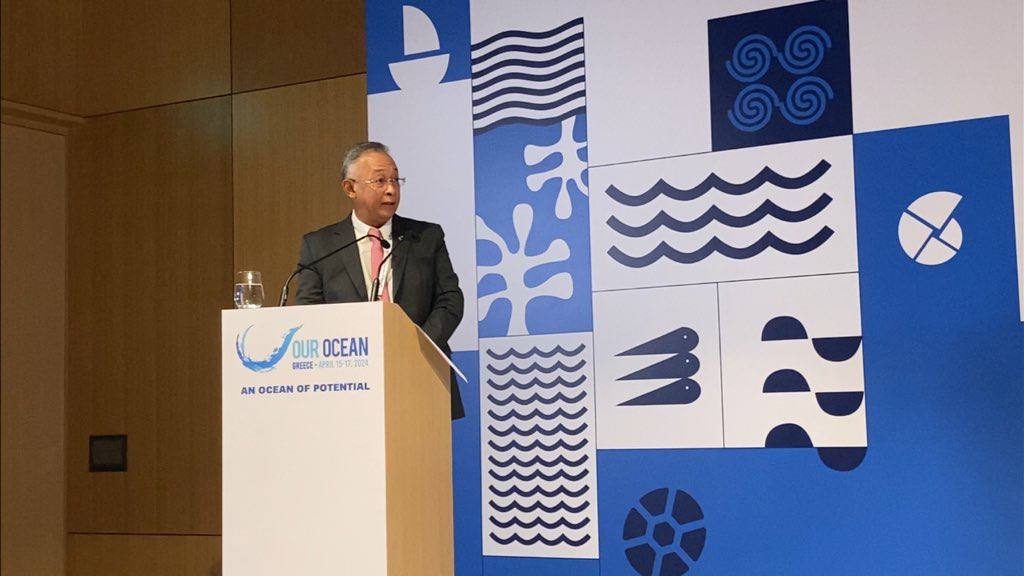SUMMARY
This is AI generated summarization, which may have errors. For context, always refer to the full article.

ATHENS, Greece – The Philippines is committing to “significantly increase” its protected areas on both land and seas by 2030.
“To achieve the 30×30 targets by the decade’s end, the Philippines, an archipelagic nation rich in biodiversity, is dedicated to significantly increasing protected areas on both land and seas,” Environment Undersecretary Ernesto Adobo Jr. said during one of the panels at the Our Ocean Conference here on Wednesday, April 17.
The 30×30 goal refers to the new global target to conserve at least 30% of the Earth by 2030.
Editor’s Note: An earlier version of this story reported that the initial roadmap developed is 80.5% of terrestrial and protected areas in the Philippines. This has been corrected.
“The Department of Environment and Natural Resources, through its Biodiversity Management Bureau, has developed an initial roadmap that projects an area coverage of 18.5% of terrestrial and 16% of marine protected areas in the Philippines under the National Integrated Protected Areas Systems, which was passed as early as 1992, and selected initially identified Other Effective Area-Based Conservation Measures or OECMs,” the environment official added.
The commitment comes just weeks after the environment department was criticized for its alleged negligence in the issuance of environmental compliance certificates (ECCs) to projects in protected areas. After the Chocolate Hills resort controversy broke in March, the department has since stripped its regional offices of the power to approve ECCs within protected areas until further notice.
Adobo, who represented the country in the conference together with Philippine Ambassador to Greece Giovanni Palec, said the department is now on its last stages of consultations in updating the country’s National Biodiversity Strategy and Action Plan, which adopts a “holistic and climate and disaster risk-sensitive roadmap.”
He added that a network of seven new science research stations located in six marine biogeographic regions will strengthen the Philippines’ capacity for “science-informed decision-making.”
In an earlier panel on coral reefs, Palec also mentioned these research stations, which the environment department announced last February.
The ambassador also noted that the Philippines this year is setting up a dedicated program for its coral reefs, especially since the country is part of the Coral Triangle that is home to the highest coral density in the world, according to the United Nations.
“The current administration puts high premium in these actions and has set aside additional funds, more than a 100% increase from the previous year, to conserve and protect marine biodiversity,” Palec said in his speech on Tuesday, April 16.
He added: “We need to look at innovative ways to sustain financing in the conservation and sustainable use efforts and maximize current technological advancements to protect our marine ecosystems with focus on the reefs. While we are paving the right direction, we are also racing against time, in view of the threats of climate change and pollution.”
The Our Ocean Conference happening in Athens aims to contribute “thematically, politically, and through its commitments” to the third United Nations (UN) Ocean Conference happening in June 2025 in Nice, France.
On Tuesday, the Philippines joined the European Union and 12 other countries in urging nations to swiftly secure the 60 ratifications needed to get into force the UN High Seas Treaty that governments formally adopted in June 2023.
In an earlier high-level event on Tuesday, Adobo had announced before heads of state delegations four new initiatives to protect oceans totaling $165.56 million:
- The protection of a projected 4.85% to 15.91% of the Philippines’ national waters by 2028 to contribute to the 30×30 goal.
- Great Blue Wall Initiative, a program that will establish a nationwide network of marine protected areas.
- Ocean Science Research Program, where new research stations will be built to gather crucial data for informed ocean management decisions.
- Fisheries and Coastal Resiliency Project, a World Bank-funded project that promotes sustainable fisheries management through developing management plans and conducting critical habitat studies.
The Our Ocean Conference closed with 469 new commitments worth $11.35 billion across the six areas of actions: marine protected areas, sustainable blue economies, climate change, maritime security, sustainable fisheries, and marine pollution. – Rappler.com
Add a comment
How does this make you feel?

















![[OPINION] Grading Marcos admin’s performance on the climate agenda](https://www.rappler.com/tachyon/2024/06/grading-marcos-performance-climate-agenda-june-25-2025.jpg?resize=257%2C257&crop=441px%2C0px%2C1080px%2C1080px)
There are no comments yet. Add your comment to start the conversation.